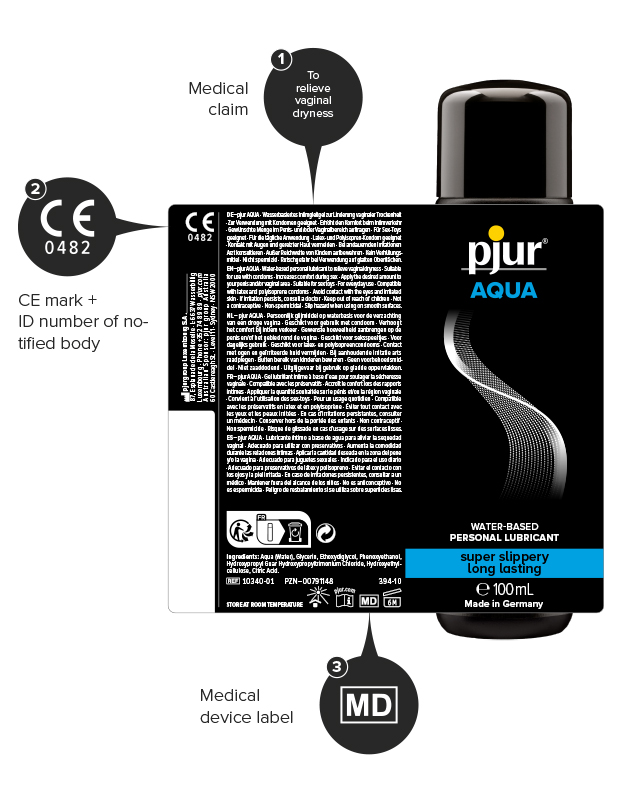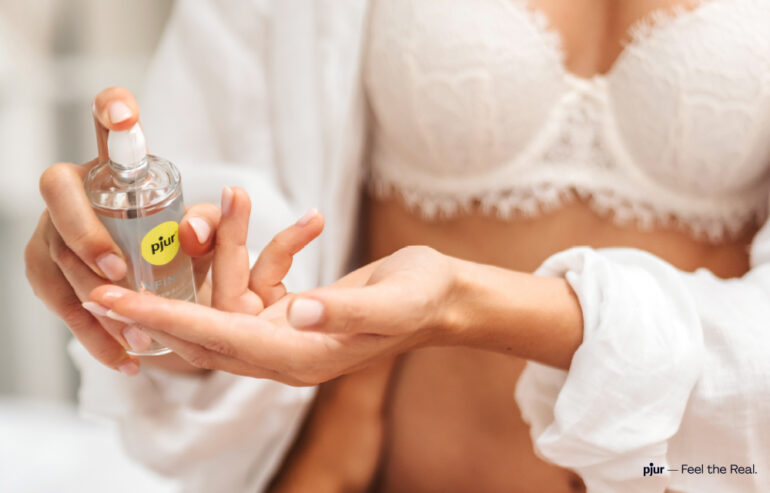
Personal lubricant shouldn’t be a taboo subject anymore. It is an aid for ensuring pleasurable sex, without pain or discomfort. Many of us buy personal lubricant at the drugstore – usually without looking carefully at the label. But did you know that personal lubricants have been classed as medical devices for a few years now and will be subject to even stricter regulation at European level from next year? We’ll explain to you what you need to look for when buying personal lubricant.
- You’ve (still) not found the right personal lubricant
- Watch out when buying personal lubricant
- How a medical lubricant should be advertised
- Silicone or water-based lubricant – understanding the differences and possibilities
- Personal lubricants during pregnancy
- Yes to personal lubricant – but only if it’s certified
You’ve (still) not found the right personal lubricant
Are you and your partner looking forward to a night of passion and you’re open to getting the best out of your sex life? Then it’s quite normal to use personal lubricant to help. Personal lubricant is actually quite an ingenious invention – it not only makes your love-making easier in certain situations, but the increased moisture levels can also send your passion soaring. That moist feeling doesn’t always occur by itself, it can also be dependent on the menstrual cycle or other physical or psychological factors.
But you’ve not been able to find the right personal lubricant yet? That’s completely normal too! Who knows from the start what they like when they’re making love – and it’s the same with personal lubricants. But anyone who delves into the world of personal lubricants will soon realise what a huge choice there is, and this can feel overwhelming: there are lubricants with or without flavours, silicone or water-based lubricants, lubricants that are edible or have a cooling or warming effect, lubricants to use with toys or to use with condoms – it seems like there’s something for everything.
Obviously, this can feel overwhelming and intimidating. We’ll help you to choose and give you tips about what to look out for.
Watch out when buying personal lubricant
Not many people are aware, but a dramatic development is imminent for personal lubricants. As a result of the new European Medical Device Regulation (MDR), which comes into force in 2024, personal lubricants will be classified in the same way as defibrillators or ventilators in the future. This means that they will be much more strictly regulated than before and will have to be officially certified. The aim of this new regulation is to create a uniform legal framework for medical devices at European level, to improve quality and consequently to increase safety for users. Many brands won’t achieve this strict but necessary certification and their products will therefore no longer be allowed to be called personal lubricants. These products will then also not provide the required level of safety, so they should no longer be introduced into the body.
Before you end up with no idea whatsoever what you can or can’t use for your next sexual adventure, we’ve summarised the key points for you to help you recognise a certified and therefore safe personal lubricant.
How a medical lubricant should be advertised
The first thing to look for on a personal lubricant are some essential symbols and claims on the label: in addition to a use-by date, a medical device must also have the MD and CE symbol on it (with a four-digit number underneath). The label must also include additional information. Here are some of the key elements: firstly, there must be an explanation of the intended use. This includes statements like ‘for daily use’, for example. Compatibility with other products should also be indicated, e.g. compatibility with condoms. Other mandatory information which must also be on a label are warnings and safety information, including statements like ‘Avoid contact with eyes and irritated skin’.

Silicone or water-based lubricant – understanding the differences and possibilities
Personal lubricants can be silicone-based, water-based, oil-based or also hybrid, meaning a mixture of water and silicone. When it comes to using them, many people want to know: What is the difference between
silicone-based and water-based?
Both formulations increase moisture levels in the vaginal or anal area and thereby reduce unpleasant friction. The water-based formula is then absorbed into the skin during sex – perfect for getting started quickly and supporting your body’s own lubrication. Water-based lubricant is also recommended when using sex toys. The big advantage of silicone-based lubricant is that it’s not absorbed into the body, making it perfect for longer-lasting love-making. You can take your time, without having to keep reapplying the product, which also makes it perfect for sensual massages as part of your foreplay. Massage and lubricant in perfect combination! 😊

Many people shy away from using silicone products because they think they might be harmful for their body, but the silicone molecules in personal lubricants are larger than the skin’s pores and therefore remain on the surface of the skin rather than being absorbed. This means that they form a protective film that ensures long-lasting lubrication. After sex, the body’s own mechanisms flush the lubricant away completely.
It’s best to stay away from alternatives to personal lubricants or substitute products, such as vaseline or saliva. It’s best that these aren’t introduced into the body as they’re not tailored to the pH-value of the vagina and can therefore damage the vaginal flora. Many of them also aren’t compatible with condoms, which means that sex will no longer be safe. Don’t forget: safety first!
There are other situations in life where safety and quality are even more important:
Personal lubricants during pregnancy
Are you pregnant? Congratulations! 😊 If you’ve decided to have a baby, you’ll notice lots of changes happening to your body while you are pregnant: your stomach will grow, your breasts will become more sensitive and, for some women, the hormonal changes in the body also result in vaginal dryness. Speak to your gynaecologist, but it’s normal to experience slightly lower moisture levels than before your pregnancy. And there’s a simple solution: personal lubricant – because there’s no need for you to give up long-lasting pleasure during (and of course after) your pregnancy, and you should be able to continue enjoying sex (pain free). You’re best placed to know whether you need to use a personal lubricant or not. Don’t forget, using a lubricant doesn’t mean that it will have a negative impact on your pregnancy, but still make sure that you choose a safe, certified product that you can use with peace of mind.
Many women are unsure which ingredients they can use during this time without any concerns. The important thing is to use a personal lubricant that is gentle on the vaginal flora, so it should therefore be tailored to the pH-value
and not contain either parabens or synthetic perfumes. The best personal lubricant to use during pregnancy is the one that you feel most comfortable with – and which suits your sexual activities.
Yes to personal lubricant – but only if it’s certified
You’ve seen how personal lubricant can become a trusted companion and help you to enjoy your love life to the full. It’s completely acceptable to use a personal lubricant – you don’t need to feel ashamed or think that there’s something wrong with your body. Why not integrate it into your foreplay and/or sex life – it’s worth it! Make sure you use a certified personal lubricant though – the label will confirm that its safe. Products advertised as pleasure creams or massage creams, for example, and not as personal lubricants, are not suitable to be introduced into the body. pjur already meets all criteria and supplies safe lubricants – only the best for you and your body!
Image sources: pexels-nothing-ahead-3230236

